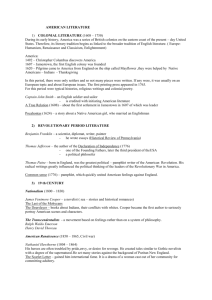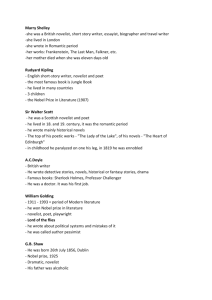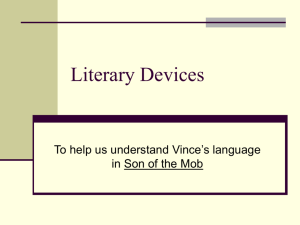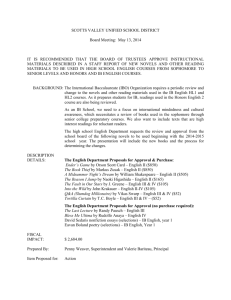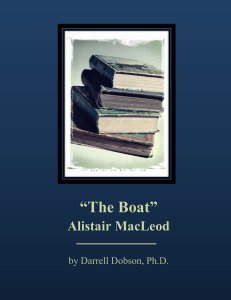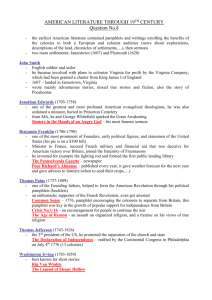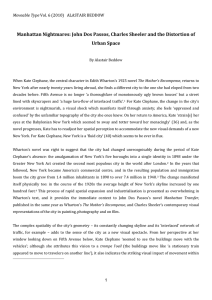The Lost Generation
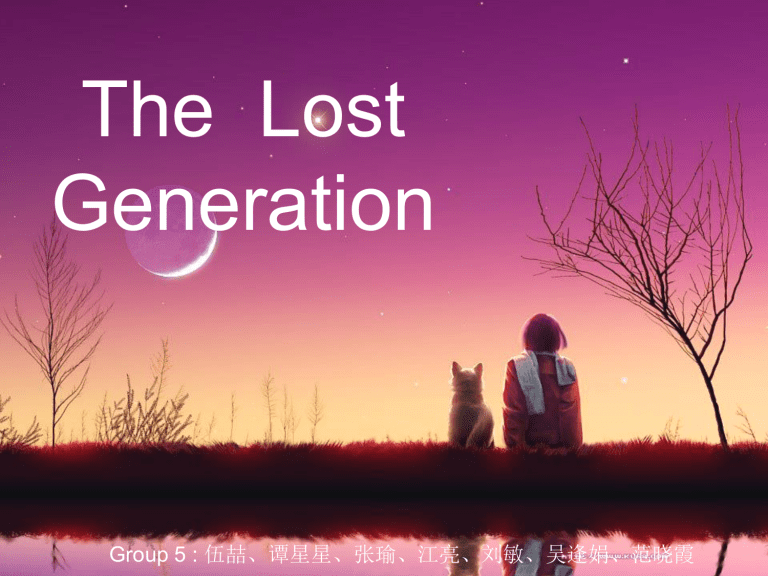
The Lost
Generation
Group 5 : 伍喆、谭星星、张瑜、江亮、刘敏、吴逢娟、范晓霞
expression "lost generation." Speaking to
Ernest Hemingway, she said, "you are all a lost generation." The term stuck and the mystique surrounding these individuals continues to fascinate us. Hemingway likely popularized the term, quoting it as epigraph to his novel, The Sun Also
Rises .
Ernest
Hemingway
(1899-1961)
World-famous American novelist and short story writer. His novels include
The Sun Also Rises
(1926),
A Farewell to Arms
(1929),
For
Whom the Bell Tolls
(1940), and
The Old Man and the Sea
(1952).
In 1954 he was awarded the highest prize a writer can receive, the
Nobel Prize for Literature
F. Scott Fitzgerald
• is remembered as the portrayer of the spirit of the Jazz age. His life is a tragic example of both sides of the American
Dream - the joys of young love, wealth and success, and the tragedies associated with excess and failure. His bestknown work is "The
Great Gatsby."
John Dos Passos and his
Three Soldiers
Dos Passos was born January 14, 1896, in
Chicago and educated at Harvard University.
He utilized his wartime experience as an ambulance driver in France as background for his first novel One Man's Initiationó1917
(1920). Both critical and popular recognition came to Dos Passos with his next bitter antiwar novel, Three Soldiers (1921). Manhattan Transfer (1925), a panoramic view of life in New York City between 1890 and 1925, became immensely successful. Containing fragments of popular songs, news headlines, stream-of-consciousness monologues, and naturalistic fragments from the lives of a horde of unrelated characters, this powerful novel determined the style of the best of his later novels. His trilogy U.S.A.
(collected in 1938), in the same style, expanded his panorama to encompass the entire nation. Comprising The 42nd Parallel (1930), 1919
(1932), and The Big Money (1936), the trilogy depicts the growth of
American materialism from the 1890s to the Great Depression of the early
1930s.
After the publication of U.S.A., Dos
Passos underwent a change of philosophy; previously radical in outlook, his philosophy became increasingly conservative. At the same time his writing became less impassioned and his style more direct and simple. He continued to produce a great deal of work, including several novels, books of personal observation, history, biography, and travel.
The best-received was Midcentury (1961), a novel in which he returned to the kaleidoscopic technique of his earlier successes to depict a panoramic view of postwar America. At the time of his death, on September 28, 1970, in Baltimore,
Maryland, Dos Passos had finished most of a novel, The Thirteenth Chronicle.
Posthumously published were Easter
Island (1971), a travel book, and The
Fourteenth Chronicle (1973), his diaries and letters. Dos Passos died in 1970, and most of his work is not yet in the public domain.
Sinclair Lewis (1885-1995)
American novelist, playwright, and social critic who gained popularity with satirical novels. Sinclair Lewis won the
Nobel Prize for Literature in 1930, the first given to American. His total output includes 22 novels and three plays.
Though Lewis criticized at times the
American way of living, his basic view of the "American human comedy" was optimistic.
"His central characters are the pioneer, the doctor, the scientist, the businessman, and the feminist. The appeal of his best fiction lies in the opposition between his idealistic protagonists and an array of fools, charlatans, and scoundrels - evangelists, editorialists, pseudo-artists, cultists, and boosters." (from
Light, 1975)
The Quixotic
Vision of Sinclair Lewis by Martin
Lewis Mumford
(1895-1990)
Urban planner, historian, sociologist, local advocate, and architectural critic
Lewis Mumford is recognized as one of the greatest urbanists of the 20th
Century. A lifelong opponent of largescale public works, much of his writings concern the effect of buildings on the human condition and the environment. Most notable of such works was the
The City in History received the National Book Award in
1961. Mumford taught at a number of prestigious universities, and served for over 30 years as architectural critic for
New Yorker
, which
. In his later years, he was awarded several distinguished honors, including the United States
Medal of Freedom and Knight of the
Order of the British Empire.
Ezra Pound
(1885-1972)
American poet and critic, often called "the poet's poet" because his profound influence on 20th century writing in English. Pound believed that poetry is the highest of arts.
He challenged many of the common views of his time and spent 12 years in an American mental hospital. Pound's major work was the Cantos , which was published in ten sections between
1925 and 1969, and then as a onevolume collected edition, THE
CANTOS OF EZRA POUND
(1970).
Pound’s major works are: Homage to Sextus Propertius; Hugh Selwyn
Manberley , and the Cantos .
Sherwood Anderson
(1876-1941)
Writer whose prose style, derived from everyday speech, influenced American short story writing between World Wars I and II. Anderson made his name as a leading naturalistic writer with his masterwork,
WINESBURG, OHIO (1919), a picture of life in a typical small
Midwestern town, as seen through the eyes of its inhabitants. Anderson's episodic
bildungsroman
has been compared often to Edgar Lee
Masters '
Spoon River Anthology
.
T. S. Eliot
(1888-1965 )
American-English poet, playwright, and literary critic, a leader of the modernist movement in literature.
Eliot was awarded the Nobel Prize for literature in 1948. His most famous work is THE WASTE
LAND, written when he was 34.
On one level it describes cultural and spiritual crisis, reflected in its use of fragmentation and discontinuity.
E. E. Cummings
(1894-1962)
American poet and painter who first attracted attention for his eccentric punctuation, but the commonly held belief that Cummings had his name legally changed to lowercase letters is erroneous.
Despite typographical eccentricity and devotion to the avantgarde, Cummings's themes are in many respect quite traditional. He often dealt with the antagonism between an individual and masses, but his style brought into his poems lightness and satirical tones. As an artist Cummings painted still-life pictures and landscapes to a professional level.
Malcolm Cowley(1898- )
American critic and poet, b.
Belsano, Pa., grad. Harvard, 1920.
He lived abroad in the 1920s and knew many writers of the “lost generation,” about whom he wrote in Exile's Return (1934) and
Second Flowering (1973). For many years he wrote a bookreview column for the New
Republic.
His works include The
Blue Juniata (1927) and A Dry
Season (1942), poems; The
Literary Situation (1954), a critical analysis; and Many Windowed
Houses: Collected Essays on
Writers and Writing (1970).
Eugene O’ Neill
(1888-1953)
One of the greatest American playwrights, restless and bold experimenter, winner of the
Nobel Prize for literature in 1936.
Among O'Neill's best-known plays are ANNA CHRISTINE
(pub. 1922), DESIRE UNDER
THE ELMS
MOURNING
(pub.1924),
BECOMES
ELECTRA (pub. 1931), LONG
DAY'S JOURNEY INTO
NIGHT (pub. 1956), and THE
ICEMAN COMETH (prod. 1946).
O'Neill's plays range in style from satire to tragedy. They often depict people who have no hope of controlling their destinies.
Edna St. Vincent
Millay (1892-1950)
American poet, who used traditional verse forms in the expression of simple, strong emotions. Millay was born in
Rockland, Maine, and educated at Vassar College.
In 1917 her collection
Renascence and Other
Poems
was published. She wrote several plays for the experimental theater group the Provincetown Players, notably
Aria da Capo
(1919), a satirical fantasy on war.
William Faulkner
(1897-1962)
The man himself never stood taller than five feet, six inches tall, but in the realm of American literature, William
Faulkner is a giant. More than simply a renowned Mississippi writer, the Nobel
Prize-winning novelist and short story writer is acclaimed throughout the world as one of the twentieth century’s greatest writers, one who transformed his “postage stamp” of native soil into an apocryphal setting in which he explored, articulated, and challenged
“the old verities and truths of the heart.” During what is generally considered his period of greatest artistic achievement, from The Sound and the Fury in 1929 to Go Down,
Moses in 1942, Faulkner accomplished in a little over a decade more artistically than most writers accomplish over a lifetime of writing.
It is one of the more remarkable feats of American literature, how a young man who never graduated from high school, never received a college degree, living in a small town in the poorest state in the nation, all the while balancing a growing family of dependents and impending financial ruin, could during the
Great Depression write a series of novels all set in the same small
Southern county — novels that include As I Lay Dying , Light in
August , and above all, Absalom,
Absalom!
— that would one day be recognized as among the greatest novels ever written by an
American.
Stephen Vincent Benét
(1898-1943)
American poet, novelist, and writer of short stories, bestknown for JOHN BROWN'S
BODY, a long epic poem on the Civil War, which Benét wrote in France. Benét received two Pulitzer prizes for his poetry. He was one of those rare poets who was both popular and critically acclaimed.
Hart Crane
(1899-1932)
He began writing verse in his early teenage years, and though he never attended college, read regularly on his own, digesting the works of the Elizabethan dramatists and poets—
Shakespeare, Marlowe, and Donne—and the nineteenth-century French poets—Vildrac,
Laforgue, and Rimbaud. His father, a candy manufacturer, attempted to dissuade him from a career in poetry, but Crane was determined to follow his passion to write. Living in New York
City, he associated with many important figures in literature of the time, including Allen Tate,
Katherine Anne Porter, E. E. Cummings, and
Jean Toomer, but his heavy drinking and chronic instability frustrated any attempts at lasting friendship. An admirer of T. S. Eliot, Crane combined the influences of European literature and traditional versification with a particularly
American sensibility derived from Walt Whitman.
His major work, the book-length poem, The
Bridge , expresses in ecstatic terms a vision of the historical and spiritual significance of
America.
Thomas Wolfe
(1900-1938)
Born October 3, 1900, Asheville, North
Carolina. Died September 15, 1938
Baltimore, Maryland. American novelist. Best known for Look Homeward, Angel
You Can’t Go Home Again
(1929) and
His views on success and failure, fame and money, and his religion.
If a man has talent and can’t use it, he’s failed.
If he uses only half of it, he has partly failed.
If he uses the whole of it, he has succeeded, and won a satisfaction and triumph few men ever know.
You have reached the pinnacle of success as soon as you become uninterested in money, compliments, or publicity.
A cult is a religion with no political power.
You can’t go home again. (his classics)
